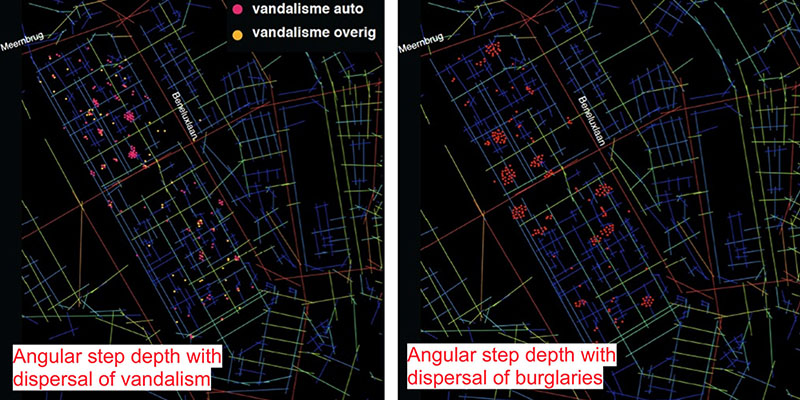Downloads
DOI:
https://doi.org/10.7480/rius.4.853Abstract
This contribution describes the tool Social Safe Urban Design (SSUD), seen together with socio-spatial and linguistic challenges when applying space syntax in the regenerating of problem urban areas. The Space Syntax jargon is technical and needs to be translated into a language understandable and acceptable to stakeholders who are responsible for the implementation of improvement strategies acceptable for the users of a neighbourhood. Moreover, the degree of public-private interface between buildings and streets needs to be incorporated in the Space Syntax analyses. As it turns out from spatial analyses and crime registrations, there is a correlation between crime and anti-social behaviour and the spatial layout of built environments in the investigated eight pilot cases. Simultaneously, there is also a challenge to come up with locally and globally functioning spatial solutions for reducing opportunities for crime and anti-social behaviour for the neighbourhoods. Proposed solutions for three of these neighbourhoods are presented in this contribution.
How to Cite
Published
Issue
Section
License
Copyright (c) 2016 Akkelies van Nes, Manuel López, Laura de Bonth, Dirk Verhagen, Simone Waaijer

This work is licensed under a Creative Commons Attribution 4.0 International License.
References
Alford, V. (1996). Crime and space in the inner city. Urban Design Studies, 2, 45-76.
Arnstein, S. R. (1969). A Ladder of Citizen Participation. JAIP, 35(4), 216-224.
Asmervik, S. (1998). Planning theory and the new rhetoric of Chaïm Perelman. Lecture notes from Oxford Brokes Planning Theory Seminar.
Forester, J. (1989). Planning in the face of power. Los Angeles, CA: University of California Press.
Hausleitner, B. (2010). Tracing scopes of action. Approaching the complexity of the urban block. (master’s thesis, EMU, TU Delft). Retrieved from http://repository.tudelft.nl/view/ir/uuid%3A60a0a285-ee46-4703-b1c5-3cdf31e8aeb4/
Hillier, B., Penn, A., Hanson, J., Grajewski, T., & Xu, J. (1998). Configurational modelling of urban movement network. Environment and Planning B: Planning and Design, (20), 29-66.
Hillier, B. & Salbaz, Ö. (2005). High Resolution Analysis of Crime Patterns in Urban Street Networks: an initial statistical sketch from an ongoing study of a London borough. In A. van Nes (ed.), Proceedings Space Syntax. 5th International Symposium at TU Delft. Delft, Netherlands: Techne Press.
Luten, I. (2008). Handboek Veilig Ontwerp en Beheer: Sociale veiligheid in buitenruimten, gebouwen en woningen. Bussum, Netherlands: Thoth.
Van Nes, A. & López, M. (2010). Macro and micro scale spatial variables and the distribution of residential burglaries and theft from cars: an investigation of space and crime in the Dutch cities of Alkmaar and Gouda. Journal of Space Syntax, 1(2), 314.
Van Nes, A. & López, M. (2013) Spatio-socio classification of deprived neighbourhouds in the Netherlands. Strategies for neighbourhood revitalisation. Proceedings of the Ninth International Space Syntax Symposium, October 31-November 3, 2013, Seoul, Korea (paper 122)
Van Nes, A., Berghauser Pont, M., & Mashhoodi, B. (2012, January). Combination of Space Syntax with Spacematrix and the Mixed Use Index. The Rotterdam South test case. In M. Greene (ed.). Proceedings Space Syntax. 8th International Symposium. Santiago, Pontificia Universidad Católica de Chile, Chili.
Rueb, L., & Van Nes, A. (2009). Spatial behaviour in Dutch dwelling areas. How housing layouts affects its users’ behaviour. In D. Koch, L. Markus, & J. Steen (eds.), Proceedings 7th International Space Syntax Symposium, Stockholm. Stockholm, KTH.
Yu, Y., & Van Nes, A. (2014). Quantitative tools in urban morphology: Combining space syntax, spacematrix and mixed-use index in a GIS framework. Journal of Urban Morphology, 18(2), 97-118.




